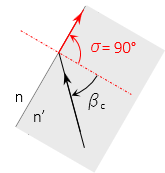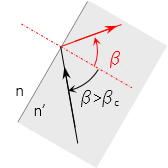4. Prisms
A prism is generally a glass block of a specific geometric shape, Figure H-7.
 |
 |
 |
| (a) Right angle | (b) Penta | (c) Dove |
| Figure H-7 Common Prisms |
||
Prisms are used to redirect and/or reorient light rays by refraction and reflection.
For light passing from a dense medium to a less dense one, Figure H-8, there is a critical incidence angle at which the refracted angle is exactly 90°
 |
| Figure H-8 Perpendicular Refraction |
The light ray does not pass out of the denser medium. The incidence angle at which this occurs is the critical angle and can be computed using Equation H-3.
 |
Equation H-3 |
When the incidence angle exceeds the critical angle, the light ray will be entirely reflected, with no part of it refracting through the interface, Figure H-9.
 |
| Figure H-9 Internal Reflection |
Prisms use this internal reflection to change the direction of light rays. Some prism applications in surveying that we'll cover later are:
- An optical plummet bends the line of sight 90° using a right angle prism
- A reflector for distance measurement uses three coinicident right angle prisms to reflect an electromagnetic signal back along its path
- An automatic level's compensator uses prisms to maintain a horizontal line of sight